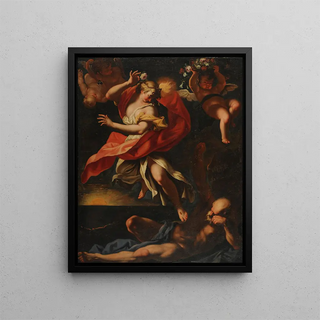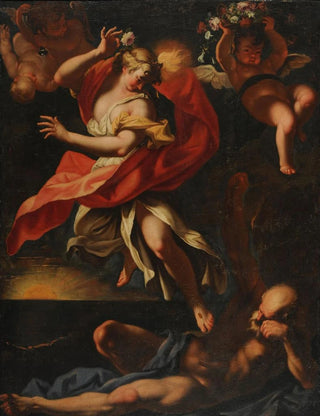Art print | Aurora and Thyton - Sebastiano Ricci Source: Reproduction | Aurora et Thyton - Sebastiano Ricci


View from behind

Frame (optional)
In the rich and complex universe of baroque art, "Aurora and Thyton" by Sebastiano Ricci stands out for its brilliance and visual poetry. This artwork, which embodies the transition from day to night, evokes mythological themes while celebrating the beauty of nature. Through vibrant colors and dynamic forms, Ricci manages to capture the essence of a fleeting moment, the one where dawn rises with grace and radiance. The scene, populated with deities and symbols, invites the viewer to immerse themselves in a world where mythology and reality intersect, creating an atmosphere that is both dreamlike and captivating.
Style and uniqueness of the artwork
Sebastiano Ricci's style is characterized by bold use of color and light, typical of Italian baroque. In "Aurora and Thyton," there is an exceptional mastery of contrasts, where warm hues of dawn blend with shadows, creating a sense of depth and movement. The figures are depicted with remarkable fluidity, their drapery seeming to float in the air, which reinforces the idea of a scene in full action. The composition is carefully orchestrated, with each element arranged to guide the viewer's eye across the painting. This dynamism is heightened by Ricci's play with the characters' expressions, giving them palpable life and emotion. Thus, the work is not merely an artistic representation but becomes a true visual narrative.
The artist and his influence
Sebastiano Ricci, born in Venice in 1659, is one of the masters of late baroque. His career led him to work in several European cities, and his style was influenced by artists such as Titian and Veronese. Ricci successfully combined Venetian tradition with more contemporary elements of his time, creating a unique visual language that left a mark on his contemporaries. His influence extends beyond his era, inspiring many artists who followed his path. The way he captured human emotions and transcribed them onto the canvas left a lasting impression.

Matte finish

View from behind

Frame (optional)
In the rich and complex universe of baroque art, "Aurora and Thyton" by Sebastiano Ricci stands out for its brilliance and visual poetry. This artwork, which embodies the transition from day to night, evokes mythological themes while celebrating the beauty of nature. Through vibrant colors and dynamic forms, Ricci manages to capture the essence of a fleeting moment, the one where dawn rises with grace and radiance. The scene, populated with deities and symbols, invites the viewer to immerse themselves in a world where mythology and reality intersect, creating an atmosphere that is both dreamlike and captivating.
Style and uniqueness of the artwork
Sebastiano Ricci's style is characterized by bold use of color and light, typical of Italian baroque. In "Aurora and Thyton," there is an exceptional mastery of contrasts, where warm hues of dawn blend with shadows, creating a sense of depth and movement. The figures are depicted with remarkable fluidity, their drapery seeming to float in the air, which reinforces the idea of a scene in full action. The composition is carefully orchestrated, with each element arranged to guide the viewer's eye across the painting. This dynamism is heightened by Ricci's play with the characters' expressions, giving them palpable life and emotion. Thus, the work is not merely an artistic representation but becomes a true visual narrative.
The artist and his influence
Sebastiano Ricci, born in Venice in 1659, is one of the masters of late baroque. His career led him to work in several European cities, and his style was influenced by artists such as Titian and Veronese. Ricci successfully combined Venetian tradition with more contemporary elements of his time, creating a unique visual language that left a mark on his contemporaries. His influence extends beyond his era, inspiring many artists who followed his path. The way he captured human emotions and transcribed them onto the canvas left a lasting impression.






